INSTITUT SUPERIEUR D'ANTHROPOLOGIE
INSTITUTE OF ANTHROPOLOGY
ONLINE COURSES / COURS A DISTANCE
WINTER TERM : JANUARY 2016
REGISTER NOW
PAKISTAN – 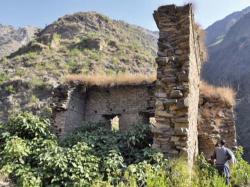 Buner - According to a six-month archaeological survey completed last week, hundreds of new archaeological sites have been registered in Buner by the Directorate of Archaeology and Museums. Archaeologists said Buner held significance in the field of archaeology; excavation and exploration will help unravel much of its history. They stated the survey had documented many untouched areas which would help document Buner’s prehistoric lifestyle and civilisation. Some archaeologists stated Buner dates back to 6 BCE. They believe the district remained under heavy Buddhist influence. “We cannot pin down its exact history in detail but the sites that have been identified can definitely be traced back to the Hindu-Shahi and prehistoric era,” said Samad. According to archaeologists working on the survey, a fort-like structure situated on top of the mountains in Gandhao, reveals a great deal about the civilisation. Samad also said the most important registered site known to the archaeologists was Ranigat. “Ranigat, literally the Queen’s rock, is situated in Totalai in Buner and will be the next detailed project to be studied and explored,” he added.
Buner - According to a six-month archaeological survey completed last week, hundreds of new archaeological sites have been registered in Buner by the Directorate of Archaeology and Museums. Archaeologists said Buner held significance in the field of archaeology; excavation and exploration will help unravel much of its history. They stated the survey had documented many untouched areas which would help document Buner’s prehistoric lifestyle and civilisation. Some archaeologists stated Buner dates back to 6 BCE. They believe the district remained under heavy Buddhist influence. “We cannot pin down its exact history in detail but the sites that have been identified can definitely be traced back to the Hindu-Shahi and prehistoric era,” said Samad. According to archaeologists working on the survey, a fort-like structure situated on top of the mountains in Gandhao, reveals a great deal about the civilisation. Samad also said the most important registered site known to the archaeologists was Ranigat. “Ranigat, literally the Queen’s rock, is situated in Totalai in Buner and will be the next detailed project to be studied and explored,” he added.
http://tribune.com.pk/story/978961/gandhao-fort-archaeologists-dig-up-buners-shahi-past/
FRANCE – Caen - Un diagnostic archéologique a principalement mis en évidence les vestiges d’un bastion (un mur épais de 4 m en pierre de Caen taillées) quasiment entier… Un exceptionnel témoignage de la fortification urbaine de la ville de Caen du début de la période moderne (XVIe siècle). Après la phase du diagnostic, des fouilles préventives ont été menées. Elles viennent d’ailleurs de s’achever. Et comme il est relevé, « se pose la question de la conservation in situ des vestiges de cette fortification. » « Un cas de figure très rare », explique l’INRAP (Institut de recherches archéologiques préventives) qui mène les fouilles, mais qui permet à l’État de demander « à l’aménageur d’intégrer les vestiges dans son projet d’aménagement. » En clair, interdit de toucher au bastion découvert, très proche de la surface du sol.
http://www.libertebonhomme.fr/2015/10/14/la-decouverte-archeologique-ne-bloquera-pas-le-%C2%AB-central-park-%C2%BB-caennais/
FRANCE – 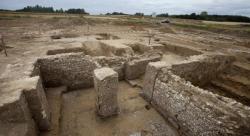 St Quentin - Passés inaperçus, les travaux menés sur la RD1 entre Tergnier et Saint-Quentin ont mis à jour un établissement routier gallo-romain, au carrefour de Rémigny et Jussy. C’est à l’automne 2014 que le site avait été repéré, lors d’un premier diagnostic conduit par le Pôle archéologie du conseil départemental. Devant l’importance des vestiges mis à jour, « l’État a décidé de poursuivre les investigations», explique Anthony Lefebvre, responsable d’opération au Pôle archéologique. Celles-ci ont été menées d’avril à juillet 2015. Des fondations en pierre révèlent « une grosse structure pour l’époque, avec probablement un étage, soit 400 m2 au total ». Les spécialistes ont ainsi émis l’hypothèse d’un relais routier gallo-romain, « parce que cela s’y prête bien en termes de topographie et de lieux ». Notamment lorsque l’on sait qu’une voie romaine épousait parfaitement la RD1 à l’endroit des fouilles. Si le site a été recouvert ensuite, pour que les travaux sur la RD1 puissent débuter, cette découverte a son importance, assure Anthony Lefebvre. « Ça permet de mieux comprendre l’organisation de l’empire, donc l’histoire sur cette période. Se rendre compte qu’il y avait une circulation des biens bien plus importante que ce que l’on pouvait penser. Et cela permet d’établir une carte de répartition de la population. » Autant d’éléments que le Pôle archéologique va approfondir à partir des vestiges prélevés sur les lieux. « Pour l’instant, le mobilier qui a été recueilli est dans nos locaux pour l’étudier, obtenir le maximum d’information. » Puis il sera transmis, comme l’ensemble des découvertes faites lors de ce type de fouilles, au Centre de conservation et d’études (CCE) de Soissons.
St Quentin - Passés inaperçus, les travaux menés sur la RD1 entre Tergnier et Saint-Quentin ont mis à jour un établissement routier gallo-romain, au carrefour de Rémigny et Jussy. C’est à l’automne 2014 que le site avait été repéré, lors d’un premier diagnostic conduit par le Pôle archéologie du conseil départemental. Devant l’importance des vestiges mis à jour, « l’État a décidé de poursuivre les investigations», explique Anthony Lefebvre, responsable d’opération au Pôle archéologique. Celles-ci ont été menées d’avril à juillet 2015. Des fondations en pierre révèlent « une grosse structure pour l’époque, avec probablement un étage, soit 400 m2 au total ». Les spécialistes ont ainsi émis l’hypothèse d’un relais routier gallo-romain, « parce que cela s’y prête bien en termes de topographie et de lieux ». Notamment lorsque l’on sait qu’une voie romaine épousait parfaitement la RD1 à l’endroit des fouilles. Si le site a été recouvert ensuite, pour que les travaux sur la RD1 puissent débuter, cette découverte a son importance, assure Anthony Lefebvre. « Ça permet de mieux comprendre l’organisation de l’empire, donc l’histoire sur cette période. Se rendre compte qu’il y avait une circulation des biens bien plus importante que ce que l’on pouvait penser. Et cela permet d’établir une carte de répartition de la population. » Autant d’éléments que le Pôle archéologique va approfondir à partir des vestiges prélevés sur les lieux. « Pour l’instant, le mobilier qui a été recueilli est dans nos locaux pour l’étudier, obtenir le maximum d’information. » Puis il sera transmis, comme l’ensemble des découvertes faites lors de ce type de fouilles, au Centre de conservation et d’études (CCE) de Soissons.
http://www.aisnenouvelle.fr/region/sous-le-bitume-les-traces-d-histoire-ia16b108n283818
France –  Montélimar - Le site mis au jour, sur 8000 m2, est une zone d'habitation. Bâtiments, palissades, enclos. Il ne reste rien de ces structures car à l'époque les hommes construisaient avec du bois et de la terre. Quelques éléments de la vie quotidienne ont été conservés comme des vases de stockage de graine. Un espace de vie donc et de travail également. Si cet espace est si exceptionnel, si remarquable c'est parce que les archéologues sont tombés sur un atelier de fondeur dont il ne reste que des fragments de terre cuite. Et ça, dans notre région, et même en France, c'est quasiment une première. Ils ont déterré des objets en bronze. Des parures, des attaches de vêtements, des anneaux, des points de flèche, des outils. Ce sont des vestiges qui sont liés au travail du métal. Au total, la fouille, qui a commencé en avril, a permis de récolter 15 mille objets. Du bronze bien-sûr mais aussi des céramiques, des os d'animaux par exemple. Certains de ces objets seront précieusement conservés, stockés, manipulés, étudiés dans les moindres détails et d'autres seront visibles dans des musées, celui de Valence peut-être. Le site existant ne deviendra pas un musée en plein air, il se transformera en site virtuel, via internet. Pourquoi ? Parce que le site découvert sera bientôt enseveli sous des milliers de tonnes de terre pour laisser la place à des logements sociaux. Cette découverte va en tout cas servir sur le plan scientifique en priorité : améliorer les connaissances sur cette période comprise entre moins 2000 et moins 1200 avant notre ère, mieux comprendre la société des hommes à l'âge de bronze, les échanges commerciaux. Ce n'est pas anodin d'avoir trouvé un tel atelier de fondeur ici. La Vallée du Rhône était forcément déjà à cette époque un important un lieu de passage nord-sud et lieu d'échanges.
Montélimar - Le site mis au jour, sur 8000 m2, est une zone d'habitation. Bâtiments, palissades, enclos. Il ne reste rien de ces structures car à l'époque les hommes construisaient avec du bois et de la terre. Quelques éléments de la vie quotidienne ont été conservés comme des vases de stockage de graine. Un espace de vie donc et de travail également. Si cet espace est si exceptionnel, si remarquable c'est parce que les archéologues sont tombés sur un atelier de fondeur dont il ne reste que des fragments de terre cuite. Et ça, dans notre région, et même en France, c'est quasiment une première. Ils ont déterré des objets en bronze. Des parures, des attaches de vêtements, des anneaux, des points de flèche, des outils. Ce sont des vestiges qui sont liés au travail du métal. Au total, la fouille, qui a commencé en avril, a permis de récolter 15 mille objets. Du bronze bien-sûr mais aussi des céramiques, des os d'animaux par exemple. Certains de ces objets seront précieusement conservés, stockés, manipulés, étudiés dans les moindres détails et d'autres seront visibles dans des musées, celui de Valence peut-être. Le site existant ne deviendra pas un musée en plein air, il se transformera en site virtuel, via internet. Pourquoi ? Parce que le site découvert sera bientôt enseveli sous des milliers de tonnes de terre pour laisser la place à des logements sociaux. Cette découverte va en tout cas servir sur le plan scientifique en priorité : améliorer les connaissances sur cette période comprise entre moins 2000 et moins 1200 avant notre ère, mieux comprendre la société des hommes à l'âge de bronze, les échanges commerciaux. Ce n'est pas anodin d'avoir trouvé un tel atelier de fondeur ici. La Vallée du Rhône était forcément déjà à cette époque un important un lieu de passage nord-sud et lieu d'échanges.
https://www.francebleu.fr/infos/culture-loisirs/un-site-archeologique-exceptionnel-mis-au-jour-montelimar-1445265702
ITALIE - 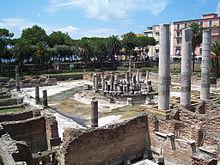 Pozzuoli - The archeological site of the ancient Roman settlement of Rione Terra, in the town of Pozzuoli west of Naples, opened over the weekend after a six-year hiatus. The first settlement of Pozzuoli, founded in 194 BC was damaged in the 1980s due to volcanic shifting of the ground level, and restored over the course of recent years. The exhibit was conceived by Adele Campanelli with the scientific guidance of Costanza Gialanella, and will remain open through March 2016. Every weekend, visitors are offered a tour along old Roman roads flanked by the ruins of shops, warehouses, workshops and private areas that ends at the magnificent Temple of Augustus, which has recently been restored with architectural solutions of great originality and incorporated in the Cathedral. The research develops through several stages of the discovery of the life of the ancient settlement. It starts from the sea with the history of the port of Pozzuoli, an important port for goods, around which grew the city whose roots were reconstructed through excavations. Of particular interest is the stop dedicated to the great Pozzuoli fish market, which still exists today and has ancient origins revisited through the discovery of the species of fish that the Romans bought in ancient cisterns. During the visit, the environment of the Pistrinum is also reconstructed, where bread was worked and Saturnalia celebrated - one of the most widespread and popular religious festivals of ancient Rome, whose unusual rites took place every year 17-23 December, in honor of Saturn.
Pozzuoli - The archeological site of the ancient Roman settlement of Rione Terra, in the town of Pozzuoli west of Naples, opened over the weekend after a six-year hiatus. The first settlement of Pozzuoli, founded in 194 BC was damaged in the 1980s due to volcanic shifting of the ground level, and restored over the course of recent years. The exhibit was conceived by Adele Campanelli with the scientific guidance of Costanza Gialanella, and will remain open through March 2016. Every weekend, visitors are offered a tour along old Roman roads flanked by the ruins of shops, warehouses, workshops and private areas that ends at the magnificent Temple of Augustus, which has recently been restored with architectural solutions of great originality and incorporated in the Cathedral. The research develops through several stages of the discovery of the life of the ancient settlement. It starts from the sea with the history of the port of Pozzuoli, an important port for goods, around which grew the city whose roots were reconstructed through excavations. Of particular interest is the stop dedicated to the great Pozzuoli fish market, which still exists today and has ancient origins revisited through the discovery of the species of fish that the Romans bought in ancient cisterns. During the visit, the environment of the Pistrinum is also reconstructed, where bread was worked and Saturnalia celebrated - one of the most widespread and popular religious festivals of ancient Rome, whose unusual rites took place every year 17-23 December, in honor of Saturn.
http://www.ansamed.info/ansamed/en/news/sections/culture/2015/10/26/exhibition-brings-ancient-pozzuoli-near-naples-to-life_8489386f-7f3b-42c2-a095-086adfed3924.html?
ROYAUME UNI - 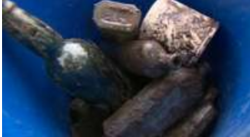 King's Lynn - Rubbish dumped during the Victorian period has been uncovered in Norfolk by a group of archaeologists. They have excavated a former town rubbish dump and the site of a former incinerator in King's Lynn. Hundreds of bottles, ash from coal fires and some dangerous metals have been uncovered in the dig.
King's Lynn - Rubbish dumped during the Victorian period has been uncovered in Norfolk by a group of archaeologists. They have excavated a former town rubbish dump and the site of a former incinerator in King's Lynn. Hundreds of bottles, ash from coal fires and some dangerous metals have been uncovered in the dig.
http://www.bbc.com/news/uk-england-norfolk-34610979
INDE – 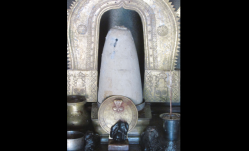 Pangala - A unique Shivalinga made from Vibhuti (sacred ash) has been found at Pangala in Udupi district. ‘Vibhuti’ is related to Lord Shiva as Shiva is believed to have smeared Vibhuti on his body. “The Shivalinga is called ‘Siddeshwara’ and is about one foot tall. The uniqueness of the linga is that it is made of Vibhuti,” Murugeshi told DC. “We have seen Lingas being carved on stones or even precious stones. Amarnath Linga is made of ice. But till date nowhere have I come across a Linga made of Vibhuti. This is one of the rare and unique Lingas in the country,” he claimed. “The Linga is covered with a metallic face of Shiva. Abhishekam and pooja are offered to the Linga after covering it with this metallic face. Though the linga is made of Vibhuti, it is not damaged,” he said adding that the Shivalinga could date back to the Keladi Nayaka period. Prof Murugeshi has also discovered a copper plate inscription in the mutt. “The inscription has 21 lines in the front and 17 lines behind. The copper plate belongs to Nayakas of Keladi and dates back to 1563 Saka era of Vikrama Savatsara, corresponding to 1641 AD,” he said. “The inscription recorded a land grant given to Mahantha Deva a disciple of Shantha Deva of Bhatkal Mutt. The granted land stated in the inscription is at Kananilahalli in Shirali hobli. The grant was by Veerabhadra Nayak. Though there is no mention of Pangala Jangama Mutt in the inscription, the mutt and Mahanta Deva might have some connections which is yet to be established,” Murugeshi said. The record is signed in the name of Vijayanagara King Sri Venkatadri of Aravidu dynasty. This was because Nayakas were subordinates of Vijayanagara Kingdom.
Pangala - A unique Shivalinga made from Vibhuti (sacred ash) has been found at Pangala in Udupi district. ‘Vibhuti’ is related to Lord Shiva as Shiva is believed to have smeared Vibhuti on his body. “The Shivalinga is called ‘Siddeshwara’ and is about one foot tall. The uniqueness of the linga is that it is made of Vibhuti,” Murugeshi told DC. “We have seen Lingas being carved on stones or even precious stones. Amarnath Linga is made of ice. But till date nowhere have I come across a Linga made of Vibhuti. This is one of the rare and unique Lingas in the country,” he claimed. “The Linga is covered with a metallic face of Shiva. Abhishekam and pooja are offered to the Linga after covering it with this metallic face. Though the linga is made of Vibhuti, it is not damaged,” he said adding that the Shivalinga could date back to the Keladi Nayaka period. Prof Murugeshi has also discovered a copper plate inscription in the mutt. “The inscription has 21 lines in the front and 17 lines behind. The copper plate belongs to Nayakas of Keladi and dates back to 1563 Saka era of Vikrama Savatsara, corresponding to 1641 AD,” he said. “The inscription recorded a land grant given to Mahantha Deva a disciple of Shantha Deva of Bhatkal Mutt. The granted land stated in the inscription is at Kananilahalli in Shirali hobli. The grant was by Veerabhadra Nayak. Though there is no mention of Pangala Jangama Mutt in the inscription, the mutt and Mahanta Deva might have some connections which is yet to be established,” Murugeshi said. The record is signed in the name of Vijayanagara King Sri Venkatadri of Aravidu dynasty. This was because Nayakas were subordinates of Vijayanagara Kingdom.
http://www.deccanchronicle.com/151026/nation-current-affairs/article/rare-shivalinga-made-sacred-ash-found-near-udupi?
EGYPTE - 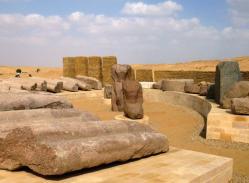 Kiman Faris - The conservation project of the ancient Greco-Roman city of Kiman Faris has been completed, Antiquities Minister Mamdouh al Damaty announced in a statement Saturday. Ancient Egyptian and Greco-Roman statues and other architectural details found at the site have been under restoration by ARCHiNOS Architecture since 2012, said Damaty. The organization also was responsible for the presentation of the artifacts that came to the site from rescue excavations in preparation for turning it to an open-air museum, he added. “Kiman Faris was one of the largest Greco-Roman cities in the Fayoum. It was established by the Greek king Ptolemy II Philadelphus (285 B.C. – 246 B.C.) and was originally inhabited by the mercenaries of his army. The site was a religious center for the worship of God Sobek; the crocodile God. The population of the prosperous city was estimated at 2,800 people,” archaeologist Fathy Khourshid told The Cairo Post Sunday. The earliest archaeological origins are at the city’s South Temple and can be traced to the 1st century B.C., he added. “The exhibited pieces are among the few physical remnants of this once prominently important city and its grand temple. The work was done as part of the URU Fayoum Project (University of California, Rijksuniversiteit Groningen and University of Auckland) under the supervision of the Egyptian Ministry of State for Antiquities. It is funded by the United States Ambassadors Fund for Cultural Preservation,” ARCHiNOS said in its webpage.
Kiman Faris - The conservation project of the ancient Greco-Roman city of Kiman Faris has been completed, Antiquities Minister Mamdouh al Damaty announced in a statement Saturday. Ancient Egyptian and Greco-Roman statues and other architectural details found at the site have been under restoration by ARCHiNOS Architecture since 2012, said Damaty. The organization also was responsible for the presentation of the artifacts that came to the site from rescue excavations in preparation for turning it to an open-air museum, he added. “Kiman Faris was one of the largest Greco-Roman cities in the Fayoum. It was established by the Greek king Ptolemy II Philadelphus (285 B.C. – 246 B.C.) and was originally inhabited by the mercenaries of his army. The site was a religious center for the worship of God Sobek; the crocodile God. The population of the prosperous city was estimated at 2,800 people,” archaeologist Fathy Khourshid told The Cairo Post Sunday. The earliest archaeological origins are at the city’s South Temple and can be traced to the 1st century B.C., he added. “The exhibited pieces are among the few physical remnants of this once prominently important city and its grand temple. The work was done as part of the URU Fayoum Project (University of California, Rijksuniversiteit Groningen and University of Auckland) under the supervision of the Egyptian Ministry of State for Antiquities. It is funded by the United States Ambassadors Fund for Cultural Preservation,” ARCHiNOS said in its webpage.
VIDEO - https://www.youtube.com/watch?v=MOV2MiHJygQ
http://www.thecairopost.com/news/173559/news/renovation-completed-at-ancient-greco-roman-kiman-faris-minister?